Experimental and Numerical Investigation of the Shear Performance of an Innovative Keyway Joint for Prefabricated Concrete Wall Panels
Abstract
:1. Introduction
2. Experimental Analysis
2.1. Test Design
2.2. Materials
2.3. Specimen Preparation
2.4. Test Setup and Measuring Instruments
2.5. Loading Method
3. Experimental Results
3.1. Experimental Observations
3.2. Shear–Slip Curves
3.3. Strain Analysis of Steel Bars
4. Numerical Simulations
4.1. Finite Element Model
4.2. Material Constitutive and Contact Behavior
4.3. Boundary Conditions and Loading Methods
4.4. Validation
5. Parameter Analysis
5.1. Axial Compression Ratio
5.2. Keyway Depth
5.3. Inclination Angles in the Keyway Joint
6. Conclusions
- The axial compression ratio had a significant impact on the failure mode of the keyway joints for prefabricated concrete wall panels. Without an axial force, the keyway joints exhibited shear brittle failure. Conversely, with an axial force, they showed compressive–shear plastic failure. As the axial compression ratio increased, both the peak and residual shear capacities of the keyway joints in the wall panels increased dramatically.
- The interface mortar strength significantly affected the shear performance of the keyway joint for prefabricated wall panels, though its influence on the residual capacity was minimal. Compared to KTKD-5 (32.3 MPa interface mortar strength), KTKD-3, with a 59 MPa interface mortar strength, exhibited a 57.2% increase in shear capacity.
- We recommend maintaining an optimal keyway depth within the range of 40 to 80 mm, resulting in an approximately 20% increase in the shear capacity of the keyway joint.
- The inclination angles for the keyway joint should be set within the range of 0° to 20°, which enhances the shear capacity of the keyway joint by about 10%.
- The innovative keyway joint exhibited a 16.5% higher shear capacity than the straight joint. Such a keyway-type joint is deemed suitable for either low-rise or multi-story prefabricated concrete wall panel structures.
Author Contributions
Funding
Data Availability Statement
Conflicts of Interest
References
- Kurama, Y.C.; Sritharan, S.; Fleischman, R.B.; Restrepo, J.I.; Henry, R.S.; Cleland, N.M.; Ghosh, S.; Bonelli, P. Seismic-resistant precast concrete structures: State of the art. J. Struct. Eng. 2018, 144, 03118001. [Google Scholar] [CrossRef]
- Pheng, L.S.; Chuan, C.J. Just-in-time management of precast concrete components. J. Constr. Eng. Manag. 2001, 127, 494–501. [Google Scholar] [CrossRef]
- Reichenbach, S.; Kromoser, B. State of practice of automation in precast concrete production. J. Build. Eng. 2021, 43, 102527. [Google Scholar] [CrossRef]
- Cao, X.; Feng, D.; Wu, G. Seismic performance upgrade of RC frame buildings using precast bolt-connected steel-plate reinforced concrete frame-braces. Eng. Struct. 2019, 195, 382–399. [Google Scholar] [CrossRef]
- Cao, X.; Shi, J.; Xu, J.; Ji, E.; She, Y.; Wang, Z. The combined influence of bond–slip and joint-shear in the seismic upgrading via externally-attached BFRP-bar reinforced precast sub-frames. J. Build. Eng. 2023, 80, 107984. [Google Scholar] [CrossRef]
- Cao, X.; Wu, G.; Ju, J.W. Seismic performance improvement of existing RCFs using external PT-PBSPC frame sub-structures: Experimental verification and numerical investigation. J. Build. Eng. 2022, 46, 103649. [Google Scholar] [CrossRef]
- Cheng, J.; Luo, X.; Cheng, Q.; Xing, M. Seismic performance of precast concrete walls with grouted sleeve connections using large-diameter bars. Soil Dyn. Earthq. Eng. 2023, 169, 107905. [Google Scholar] [CrossRef]
- Sha, M.; Liu, P.; Gao, J.; Ma, H. Research status and application of prefabricated concrete frame joints. E3S Web Conf. 2021, 260, 03025. [Google Scholar] [CrossRef]
- Peng, W.; Sui Pheng, L. Managing the embodied carbon of precast concrete columns. J. Mater. Civ. Eng. 2011, 23, 1192–1199. [Google Scholar] [CrossRef]
- Pul, S.; Senturk, M.; Ilki, A.; Hajirasouliha, I. Experimental and numerical investigation of a proposed monolithic-like precast concrete column-foundation connection. Eng. Struct. 2021, 246, 113090. [Google Scholar] [CrossRef]
- Rave-Arango, J.F.; Blandón, C.A.; Restrepo, J.I.; Carmona, F. Seismic performance of precast concrete column-to-column lap-splice connections. Eng. Struct. 2018, 172, 687–699. [Google Scholar] [CrossRef]
- Korkmaz, H.H.; Tankut, T. Performance of a precast concrete beam-to-beam connection subject to reversed cyclic loading. Eng. Struct. 2005, 27, 1392–1407. [Google Scholar] [CrossRef]
- Li, H.; Chen, W.; Hao, H. Dynamic response of precast concrete beam with wet connection subjected to impact loads. Eng. Struct. 2019, 191, 247–263. [Google Scholar] [CrossRef]
- Choi, H.-K.; Choi, Y.-C.; Choi, C.-S. Development and testing of precast concrete beam-to-column connections. Eng. Struct. 2013, 56, 1820–1835. [Google Scholar] [CrossRef]
- Ghayeb, H.H.; Razak, H.A.; Sulong, N.R. Development and testing of hybrid precast concrete beam-to-column connections under cyclic loading. Constr. Build. Mater. 2017, 151, 258–278. [Google Scholar] [CrossRef]
- Guan, D.; Jiang, C.; Guo, Z.; Ge, H. Development and seismic behavior of precast concrete beam-to-column connections. J. Earthq. Eng. 2018, 22, 234–256. [Google Scholar] [CrossRef]
- Gudonis, E.; Timinskas, E.; Gribniak, V.; Kaklauskas, G.; Arnautov, A.K.; Tamulėnas, V. FRP reinforcement for concrete structures: State-of-the-art review of application and design. Eng. Struct. Technol. 2013, 5, 147–158. [Google Scholar] [CrossRef]
- Li, W.; Li, Q.-N.; Jiang, W.-S.; Jiang, L. Seismic performance of composite reinforced concrete and steel moment frame structures–state-of-the-art. Compos. Part B Eng. 2011, 42, 190–206. [Google Scholar] [CrossRef]
- Williams, M.S.; Sexsmith, R.G. Seismic damage indices for concrete structures: A state-of-the-art review. Earthq. Spectra 1995, 11, 319–349. [Google Scholar] [CrossRef]
- Santos, P.M.; Júlio, E.N. A state-of-the-art review on shear-friction. Eng. Struct. 2012, 45, 435–448. [Google Scholar] [CrossRef]
- Divan, M.; Madhkhan, M. Determination of behavior coefficient of prefabricated concrete frame ith prefabricated shear walls. Procedia Eng. 2011, 14, 3229–3236. [Google Scholar] [CrossRef]
- Gu, Q.; Wu, R.; Ren, J.; Tan, Y.; Tian, S.; Wen, S. Effect of position of non-contact lap splices on in-plane force transmission performance of horizontal joints in precast concrete double-face superposed shear wall structures. J. Build. Eng. 2022, 51, 104197. [Google Scholar] [CrossRef]
- Cheng, J.; Luo, X.; Cheng, L.; Cheng, Q.; Chen, L. Experimental Study on Seismic Behavior of PC Walls with Alveolar-Type Horizontal Joint under Pseudo-Static Loading. Materials 2022, 15, 2301. [Google Scholar] [CrossRef] [PubMed]
- Dang, L.; Pang, R.; Liu, Y.; Wang, Y.; Wang, L.; Yang, J. Research on seismic performance of precast steel–concrete composite tube shear walls with horizontal joint. Eng. Struct. 2022, 250, 113409. [Google Scholar] [CrossRef]
- Guri, M.; Brzev, S.; Lluka, D. Performance of prefabricated large panel reinforced concrete buildings in the November 2019 Albania earthquake. J. Earthq. Eng. 2022, 26, 5799–5825. [Google Scholar] [CrossRef]
- Chuai, J.; Hou, Z.; Wang, Z.; Wang, L. Mechanical properties of the vertical joints of prefabricated underground silo steel plate concrete wall. Adv. Civ. Eng. 2020, 2020, 6643811. [Google Scholar] [CrossRef]
- Liu, J.; Wang, B.; Chu, M.; Zhang, P.; Wang, B. Influence of the axial load ratio on the mechanical behaviour of prefabricated concrete shear walls with Mortise–Tenon joints. Structures 2023, 53, 83–97. [Google Scholar] [CrossRef]
- Ibrahim, I.S.; Padil, K.H.; Mansoor, H.; Bady, A.; Saim, A.A.; Sarbini, N.N.; Bady, H.; Saim, A.; Sarbini, N. Ultimate shear capacity and failure of shear key connection in precast concrete construction. Malays. J. Civ. Eng. 2014, 26, 414–430. [Google Scholar]
- Rizkalla, S.H.; Serrette, R.L.; Heuvel, J.S.; Attiogbe, E.K. Multiple shear key connections for precast shear wall panels. PCI J. 1989, 34, 104–120. [Google Scholar] [CrossRef]
- Al-Bared, M.A.; Harahap, I.S.; Marto, A.; Mohamad, H.; Abad, S.V.A.N.K.; Mustaffa, Z. Cyclic behavior of RT-cement treated marine clay subjected to low and high loading frequencies. Geomech. Eng. 2020, 21, 433–445. [Google Scholar]
- Chaiyasarn, K.; Buatik, A.; Mohamad, H.; Zhou, M.; Kongsilp, S.; Poovarodom, N. Integrated pixel-level CNN-FCN crack detection via photogrammetric 3D texture mapping of concrete structures. Autom. Constr. 2022, 140, 104388. [Google Scholar] [CrossRef]
- Mohamad, H.; Bennett, P.J.; Soga, K.; Klar, A.; Pellow, A. Distributed optical fiber strain sensing in a secant piled wall. In Proceedings of the 7th FMGM 2007: Field Measurements in Geomechanics, Boston, MA, USA, 24–27 September 2007; pp. 1–12. [Google Scholar]
- Rashid, A.S.A.; Shirazi, M.G.; Mohamad, H.; Sahdi, F. Bearing capacity of sandy soil treated by Kenaf fibre geotextile. Environ. Earth Sci. 2017, 76, 431. [Google Scholar] [CrossRef]
- Xiao, Y.; Luo, X.; Xing, M.; Pan, Z.; Cheng, J.; Liu, J. Simplified Analytical Methods for Prefabricated Concrete Wall Panel Building System with Alveolar-Type Joints. Buildings 2023, 13, 1177. [Google Scholar] [CrossRef]
- Cheng, B.; Cai, Y.; Looi, D.T. Experiment and numerical study of a new bolted steel plate horizontal joints for precast concrete shear wall structures. Structures 2021, 32, 760–777. [Google Scholar] [CrossRef]
- Biswal, A.; Prasad, A.M.; Sengupta, A.K. Study of shear behavior of grouted vertical joints between precast concrete wall panels under direct shear loading. Struct. Concr. 2019, 20, 564–582. [Google Scholar] [CrossRef]
- Zhao, Y.; Zou, R.; Ding, T.; Xiao, J. Experimental study of the shear behaviour of concrete-grout-concrete joints. J. Build. Eng. 2021, 43, 103095. [Google Scholar] [CrossRef]
- Zhou, Y.; Zhang, B.; Hwang, H.-J.; Xi, S.; Fang, L.; Huang, Y.; Yi, W. Tensile and shear behavior of box connector for precast concrete shear walls. Eng. Struct. 2021, 245, 112983. [Google Scholar] [CrossRef]
- Cholewicki, A. Loadbearing capacity and deformability of vertical joints in structural walls of large panel buildings. Build. Sci. 1971, 6, 163–184. [Google Scholar] [CrossRef]
- Soudki, K.A.; West, J.S.; Rizkalla, S.H.; Blackett, B. Horizontal connections for precast concrete shear wall panels under cyclic shear loading. PCI J. 1996, 41, 64–80. [Google Scholar] [CrossRef]
- Castillo, T.; Paredes, M.; Andrade, A.; Arroba, V.; Guerrero, J. Off-Site Construction of Concrete Housing in the Andean Region: Advantages and Disadvantages. Civ. Eng. Archit. 2022, 10, 477–489. [Google Scholar] [CrossRef]
- Ding, K.W.; Ling, R.; Yin, W.Y.; Liu, S.C.; Ni, S.M. Reviews on the research status and prospect of the prefabricated concrete shear wall structure. Appl. Mech. Mater. 2013, 291, 1021–1024. [Google Scholar] [CrossRef]
- Yang, S. The Development and Application of Prefabricated Buildings. Highlights Sci. Eng. Technol. 2022, 18, 162–167. [Google Scholar] [CrossRef]
- JGJ/T101-2015; Specification for Seismic Test of Buildings. China Academy of Building Research: Beijing, China, 2015.
- GB 50010-2010; Code for Design of Concrete Structures. China Academy of Building Research: Beijing, China, 2010.
- Wriggers, P. Computational Contact Mechanics; Springer: Berlin, Germany, 2006. [Google Scholar]
- ABAQUS. ABAQUS 6.14: User’s Manual; Dassault Systemes Simulia Corporation: Providence, RI, USA, 2014. [Google Scholar]
- Grassl, P.; Jirásek, M. Plastic model with non-local damage applied to concrete. Int. J. Numer. Anal. Methods Geomech. 2006, 30, 71–90. [Google Scholar] [CrossRef]
- Grassl, P.; Nystrom, U.; Rempling, R.; Gylltoft, K. A damage-plasticity model for the dynamic failure of concrete. arXiv 2011, arXiv:1103.1288. [Google Scholar]

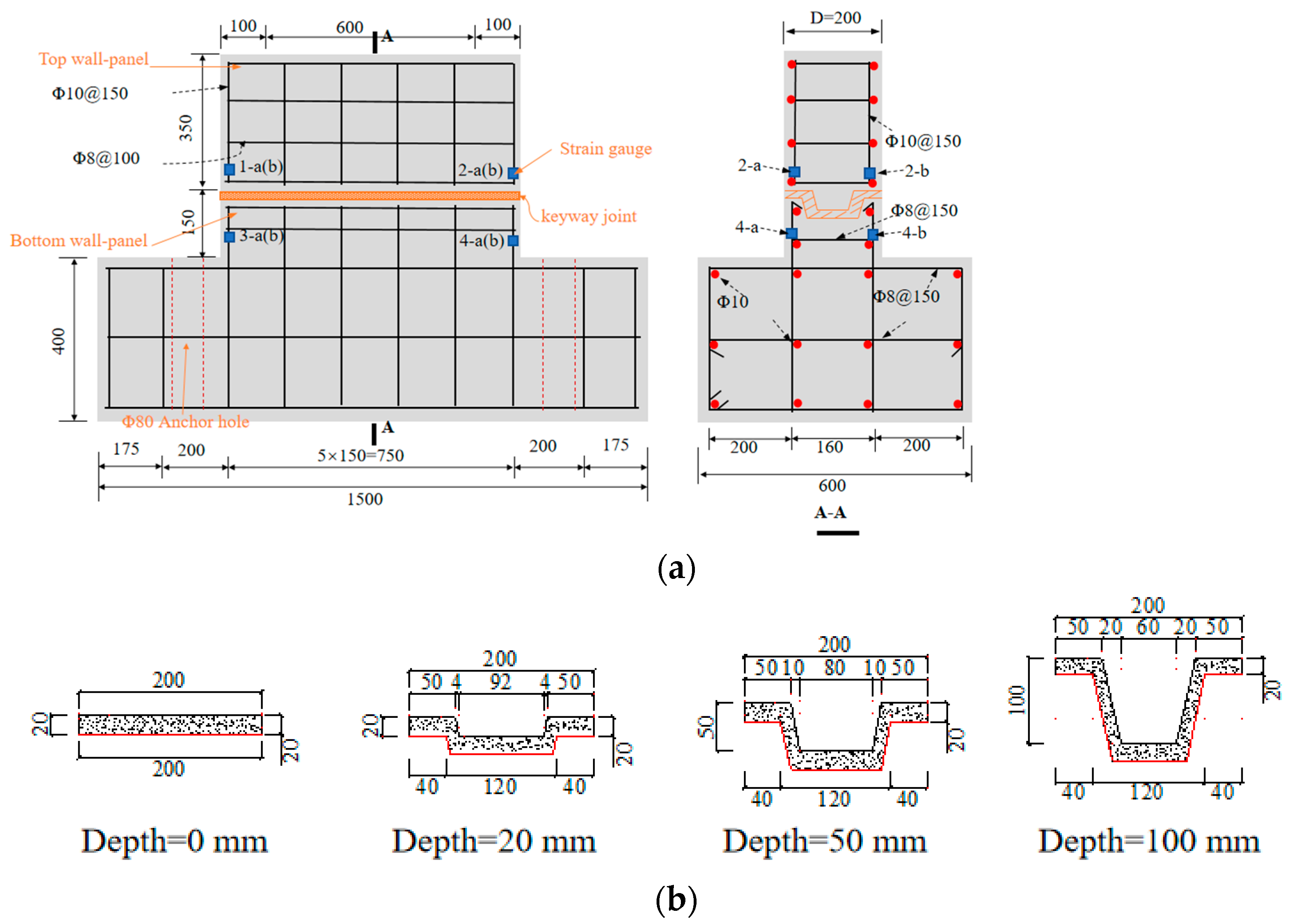
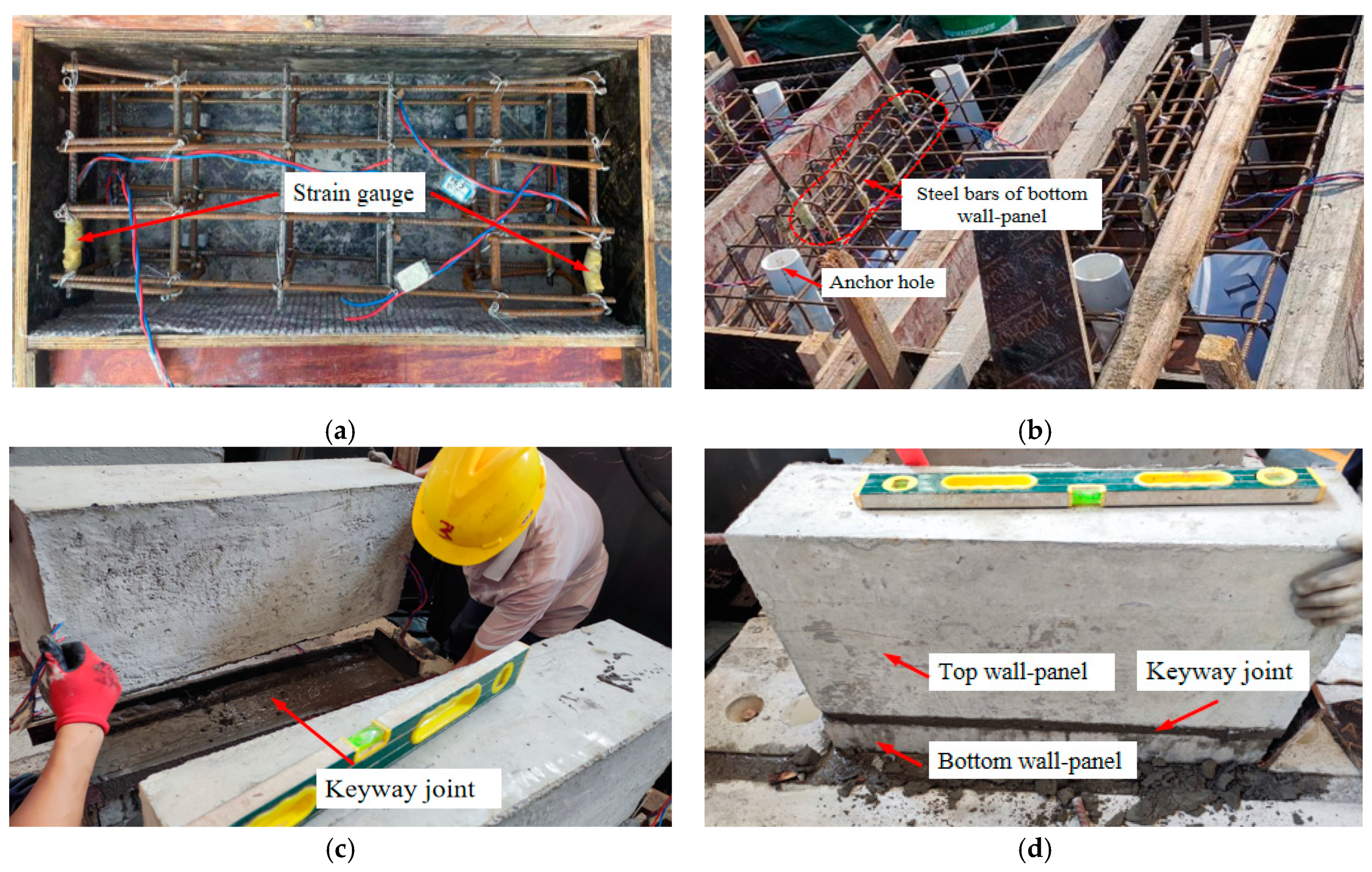
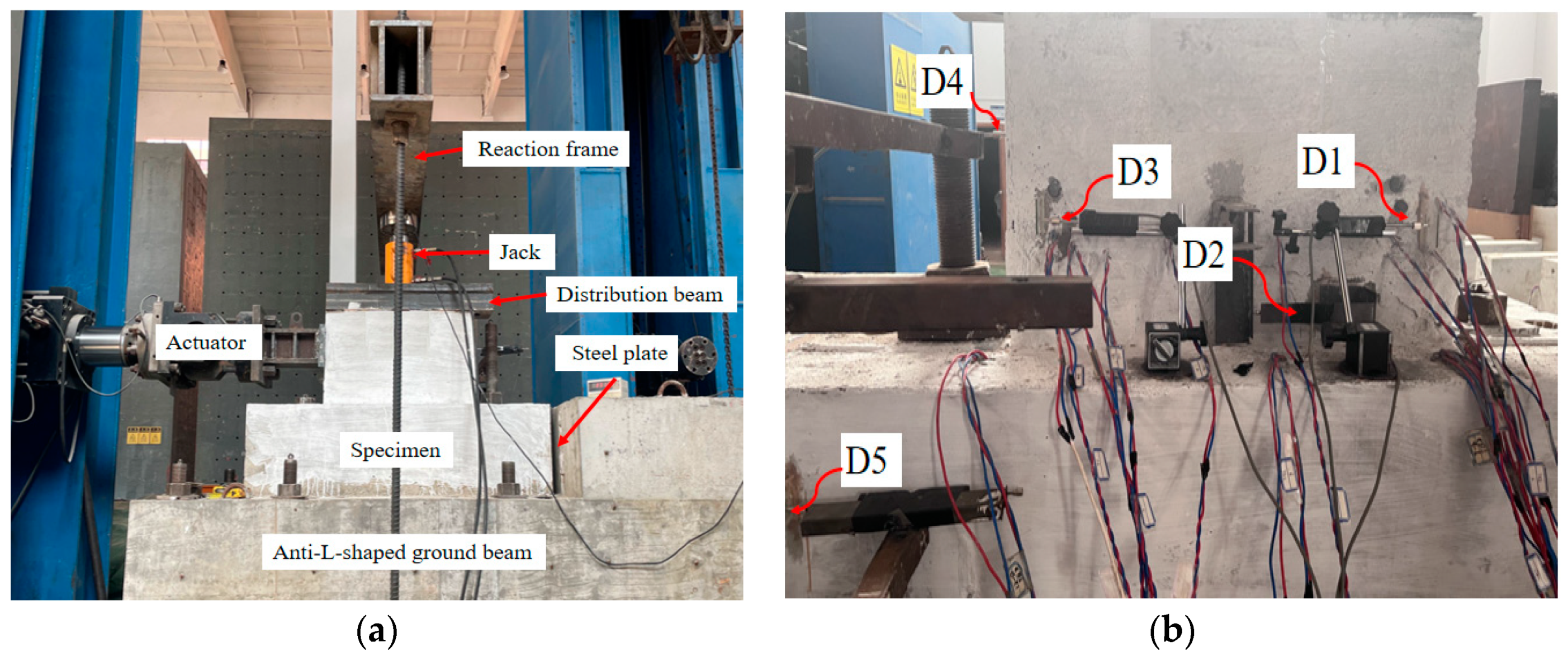
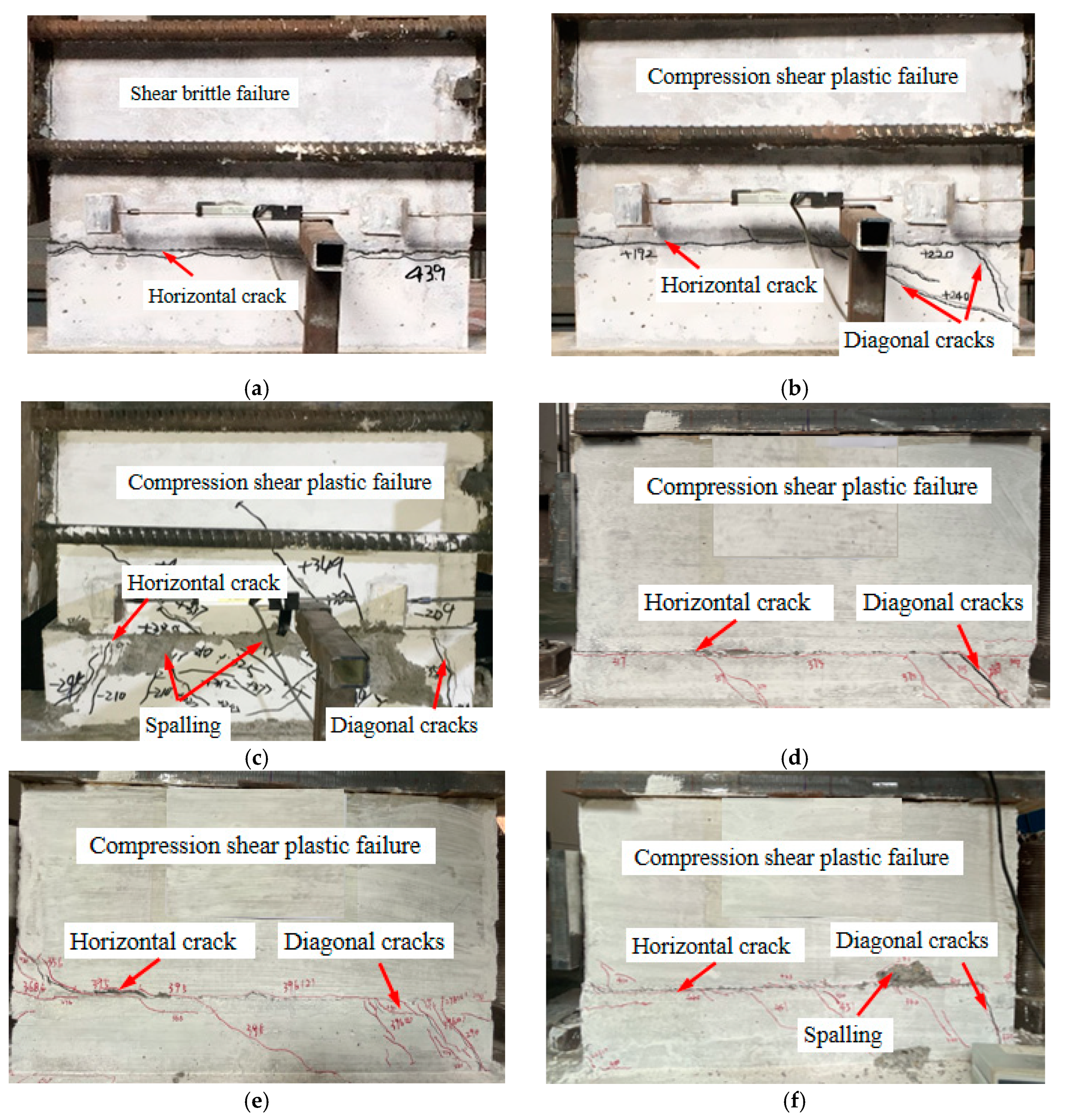
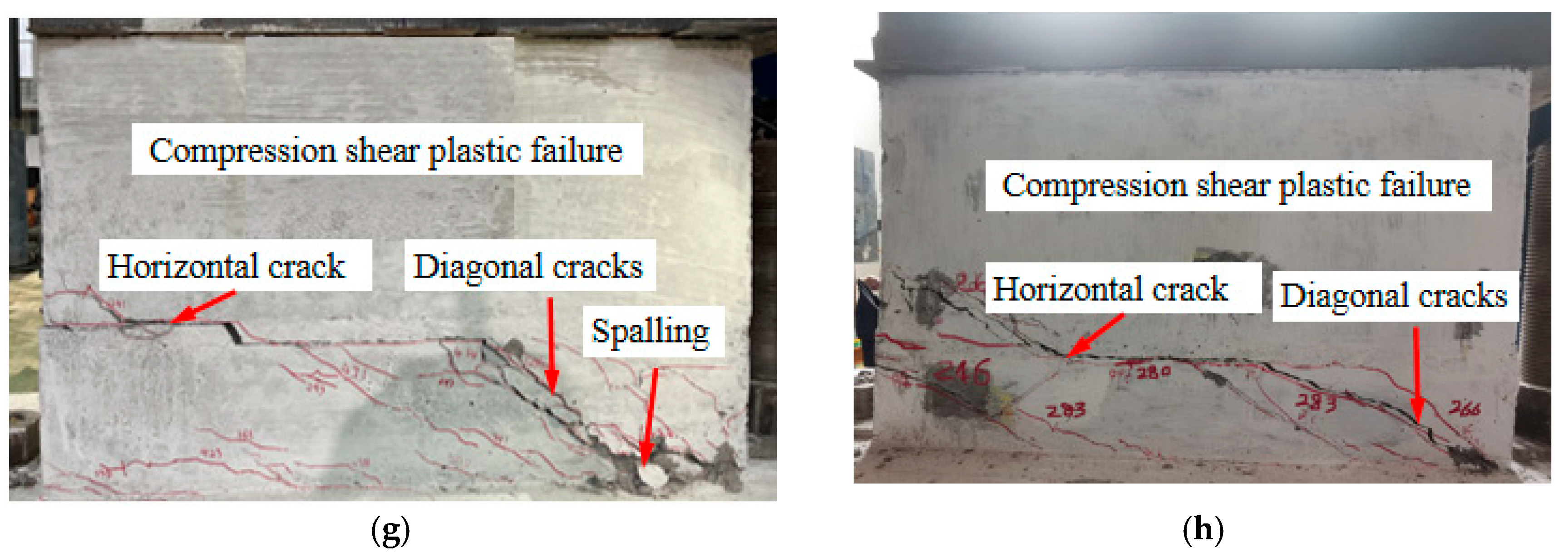
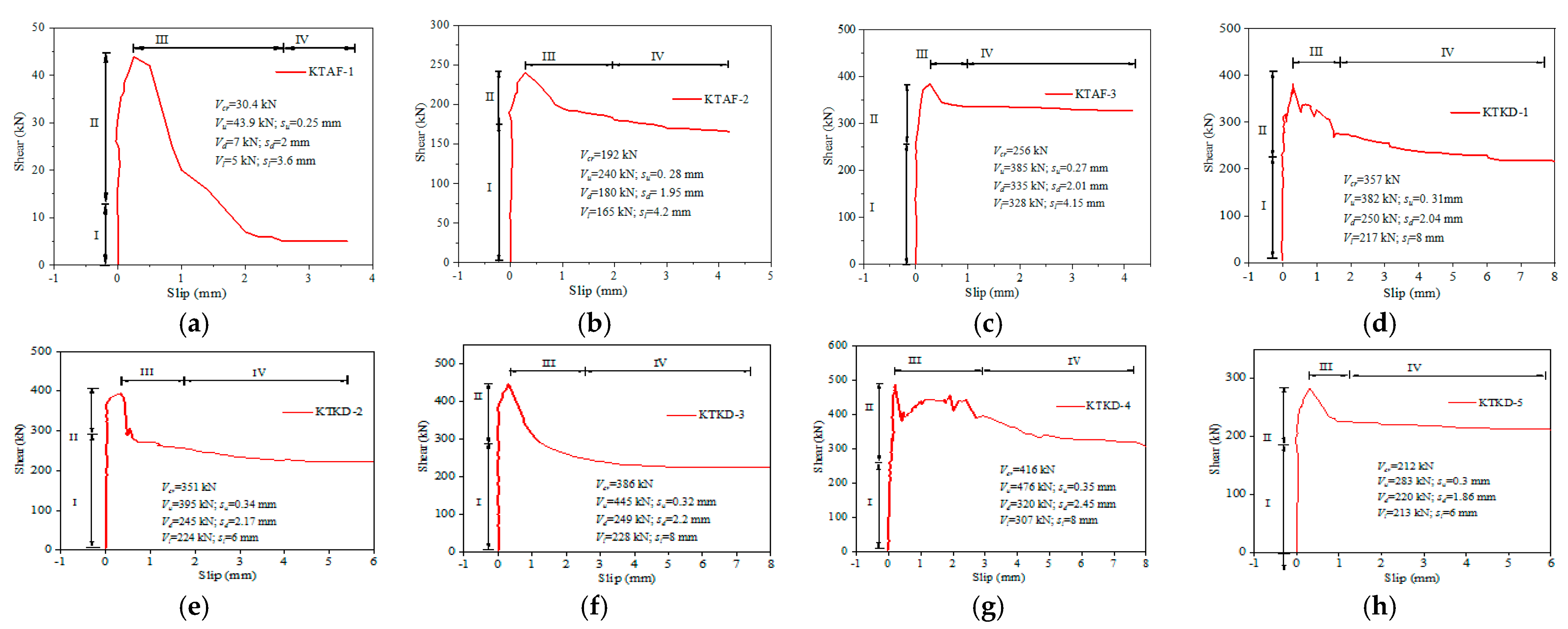
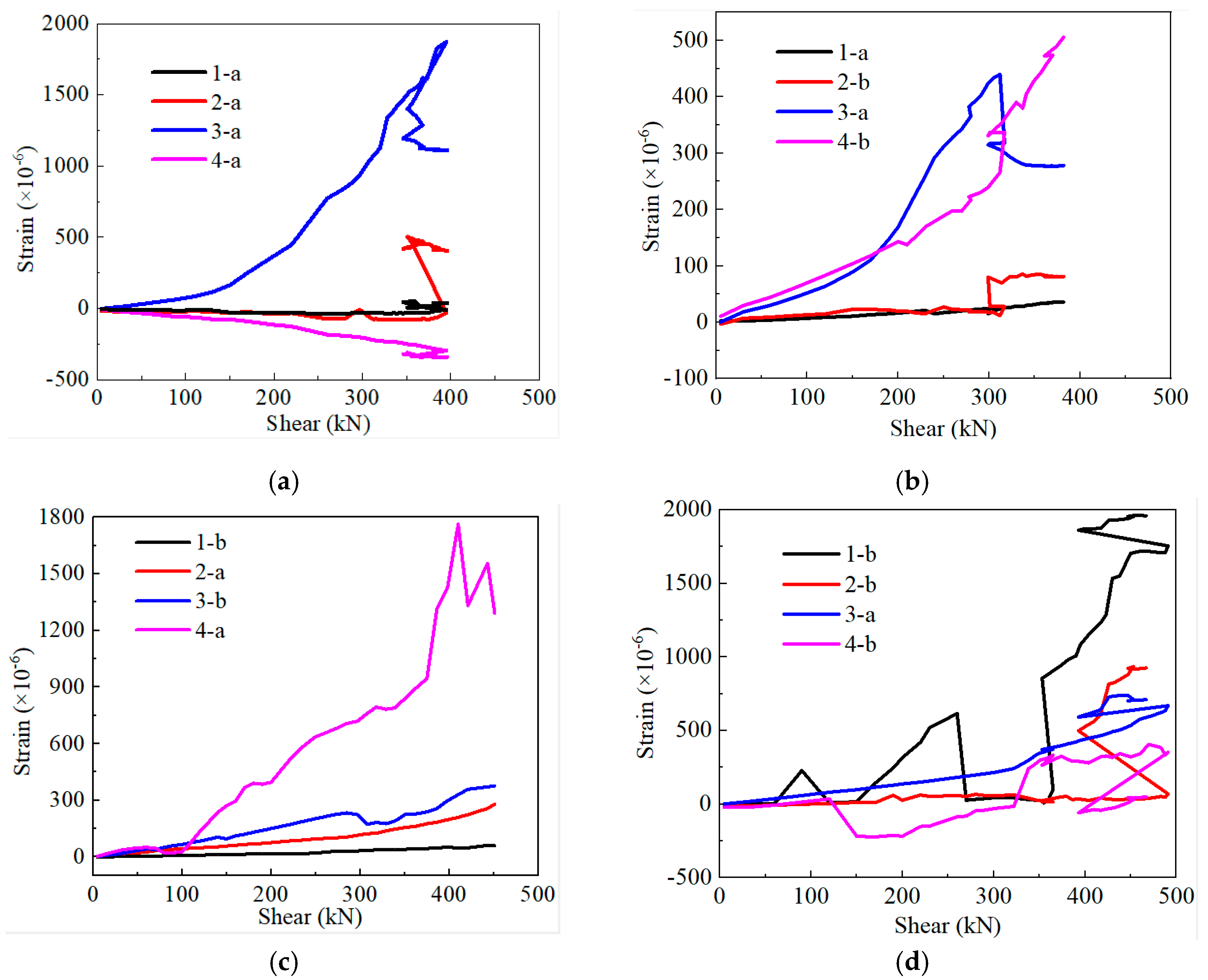



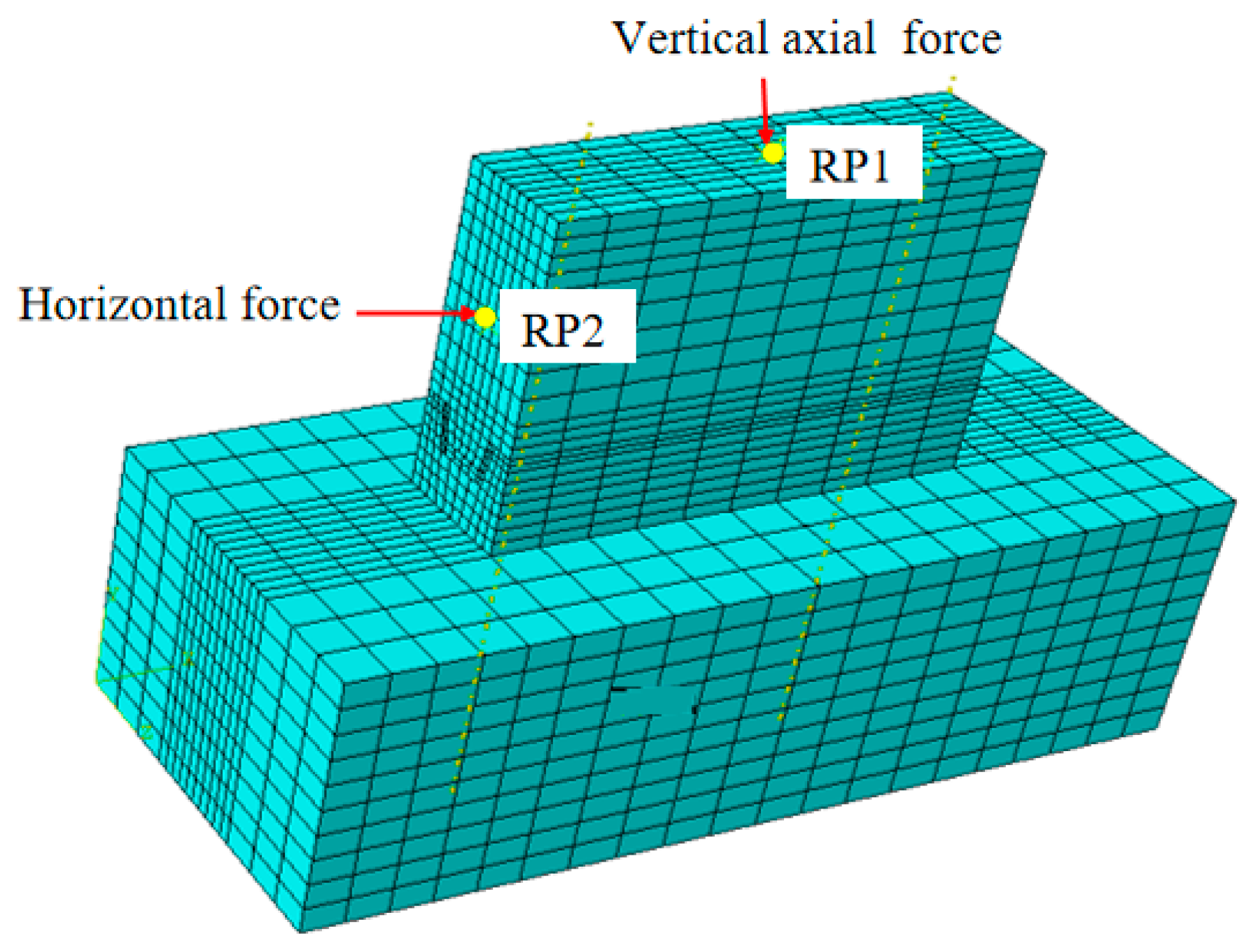
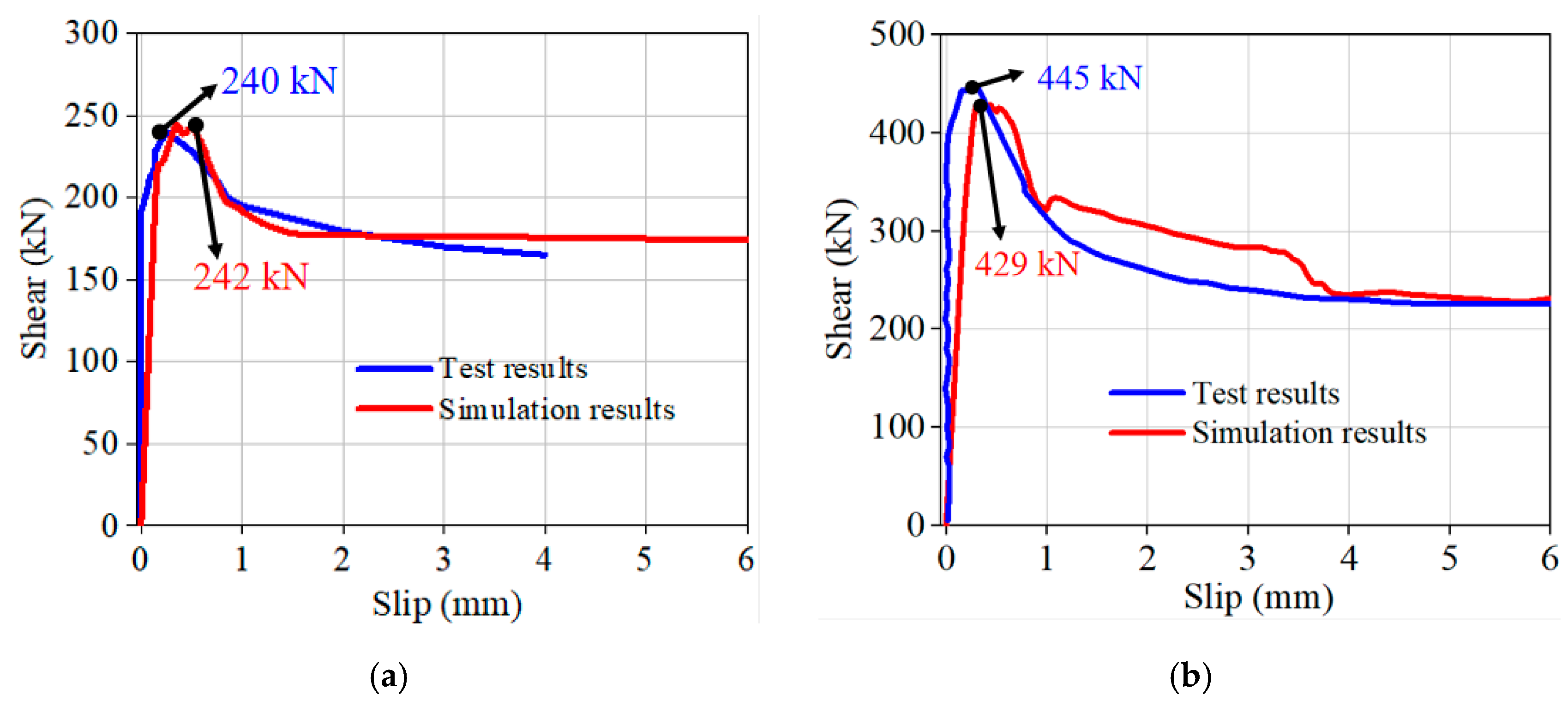
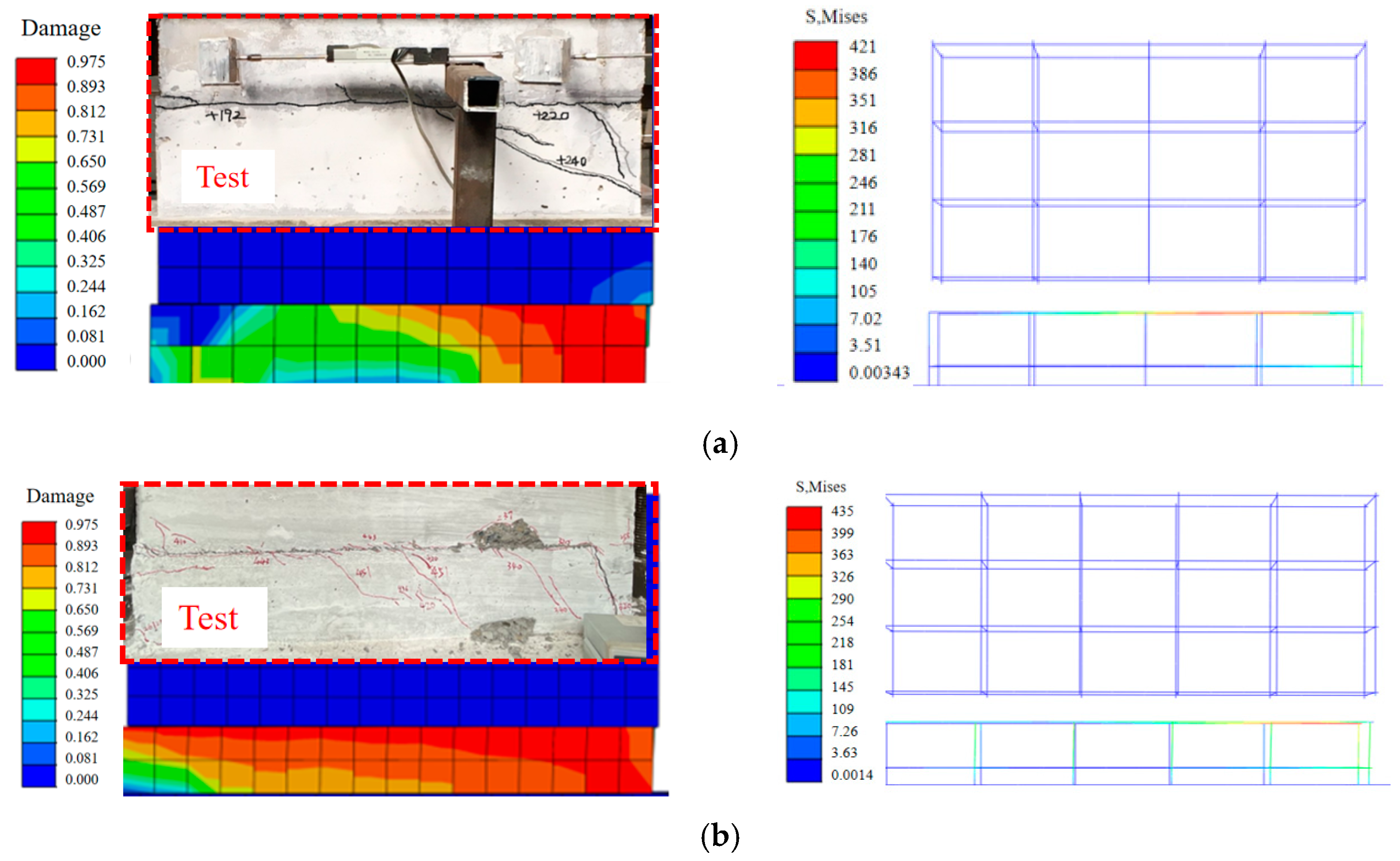
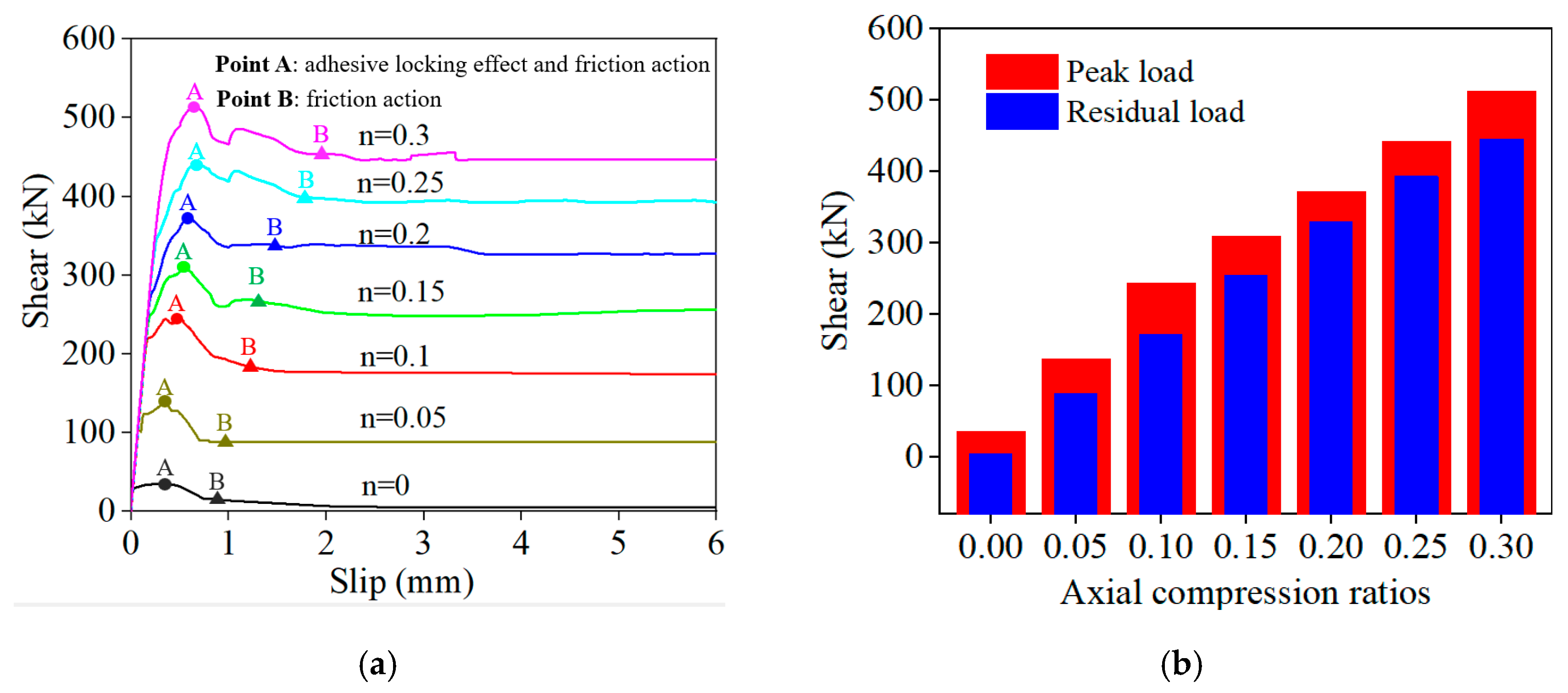
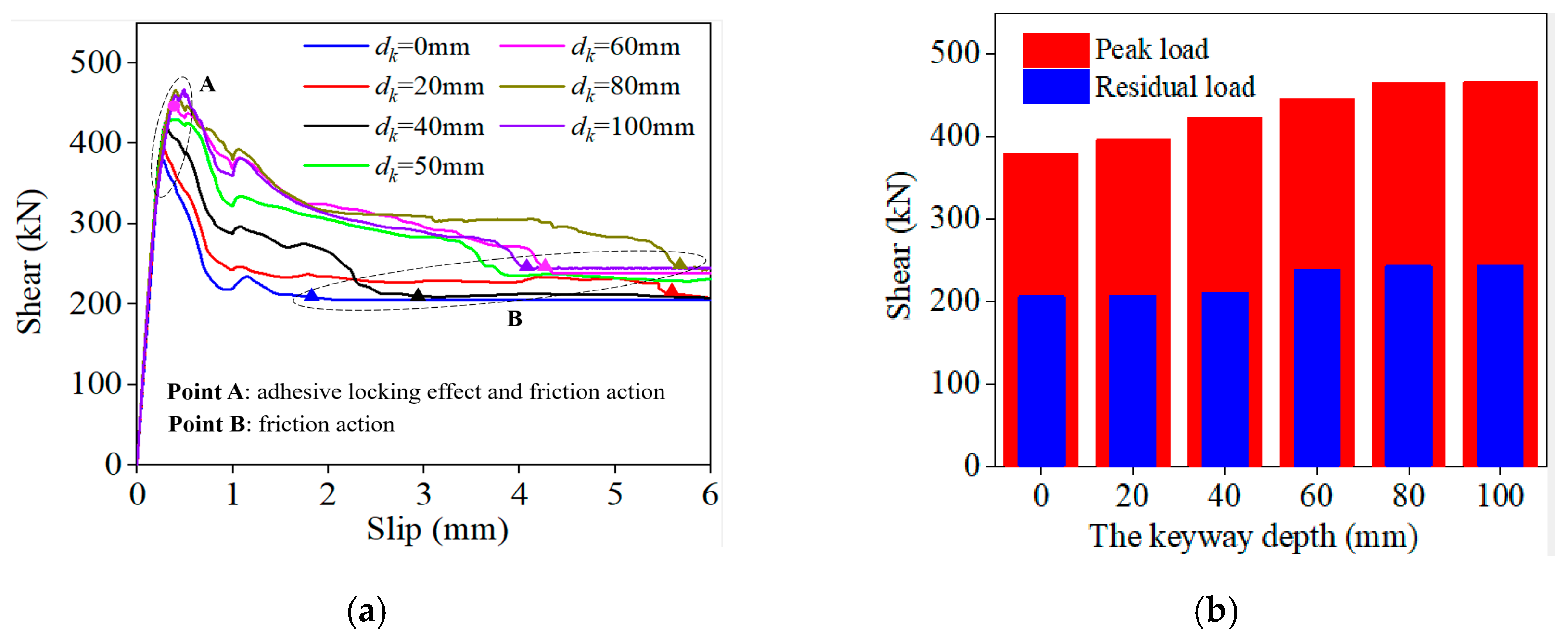

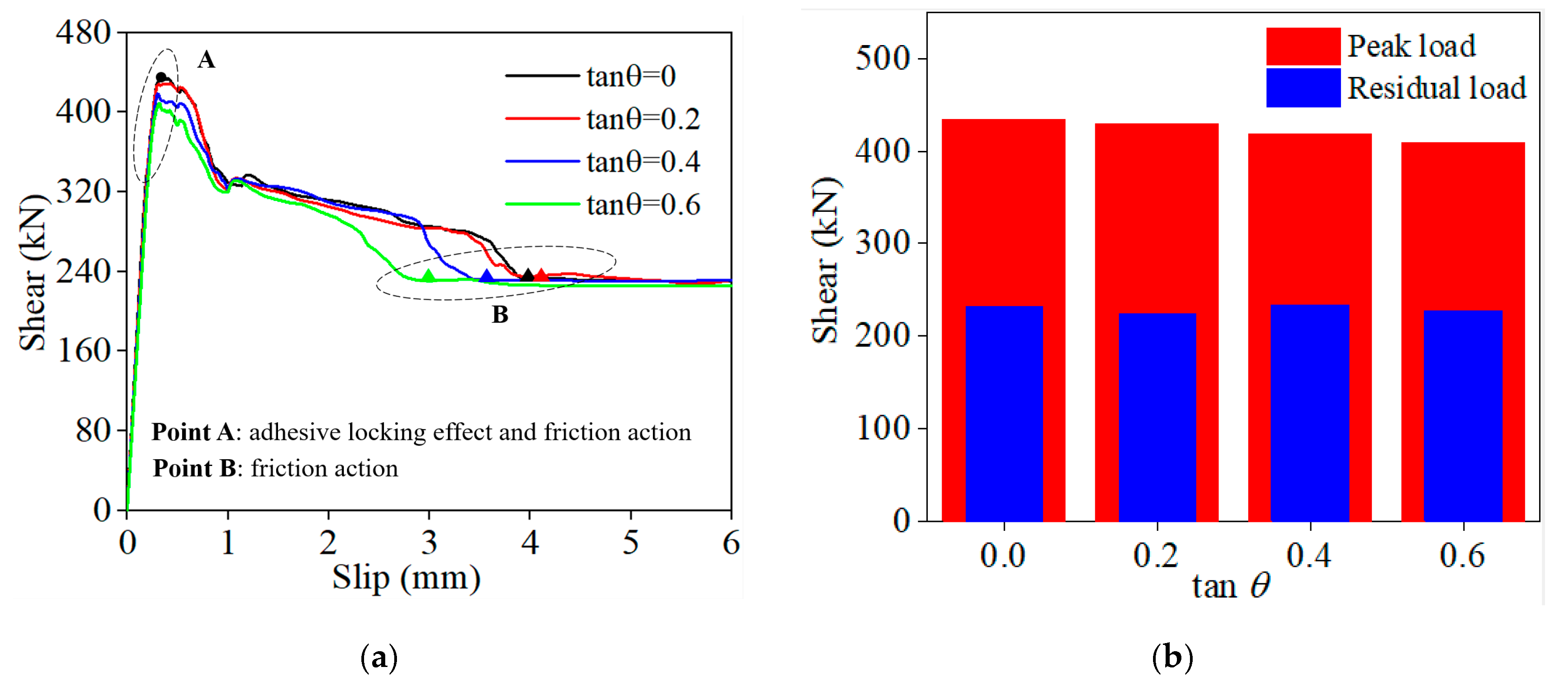
| Specimens No. | dk (mm) | λ | AK (mm2) | n | Axial Force (kN) | fc,p (MPa) |
|---|---|---|---|---|---|---|
| KTAF-1 | 50 | 0.49 | 600 × 282 | 0 | 0 | 32.3 |
| KTAF-2 | 50 | 0.49 | 600 × 282 | 0.1 | 171.6 | 32.3 |
| KTAF-3 | 50 | 0.49 | 600 × 282 | 0.2 | 343.2 | 32.3 |
| KTKD-1 | 0 | 0.37 | 800 × 200 | 0.1 | 228.8 | 59 |
| KTKD-2 | 20 | 0.37 | 800 × 232 | 0.1 | 228.8 | 59 |
| KTKD-3 | 50 | 0.37 | 800 × 282 | 0.1 | 228.8 | 59 |
| KTKD-4 | 100 | 0.37 | 800 × 344 | 0.1 | 228.8 | 59 |
| KTKD-5 | 50 | 0.37 | 800 × 282 | 0.1 | 228.8 | 32.3 |
| Specimens | ||
|---|---|---|
| KTAF-1 | 0.69 | 1.40 |
| KTAF-2 | 0.8 | 1.09 |
| KTAF-3 | 0.66 | 1.02 |
| KTKD-1 | 0.93 | 1.15 |
| KTKD-2 | 0.89 | 1.09 |
| KTKD-3 | 0.87 | 1.09 |
| KTKD-4 | 0.87 | 1.04 |
| KTKD-5 | 0.75 | 1.03 |
| Contact | Normal Behavior | Tangential Behavior | Specimens | Surface-Based Cohesive Behavior |
|---|---|---|---|---|
| Face-to-face contact | Hard contact | ) | For KTAF-1~ KTAF-3 | ; ; |
| For KTKD-1~KTKD-5 | ; |
Disclaimer/Publisher’s Note: The statements, opinions and data contained in all publications are solely those of the individual author(s) and contributor(s) and not of MDPI and/or the editor(s). MDPI and/or the editor(s) disclaim responsibility for any injury to people or property resulting from any ideas, methods, instructions or products referred to in the content. |
© 2023 by the authors. Licensee MDPI, Basel, Switzerland. This article is an open access article distributed under the terms and conditions of the Creative Commons Attribution (CC BY) license (https://creativecommons.org/licenses/by/4.0/).
Share and Cite
Cheng, L.; Gui, Y.; Cheng, J.; Xing, M. Experimental and Numerical Investigation of the Shear Performance of an Innovative Keyway Joint for Prefabricated Concrete Wall Panels. Buildings 2023, 13, 2978. https://doi.org/10.3390/buildings13122978
Cheng L, Gui Y, Cheng J, Xing M. Experimental and Numerical Investigation of the Shear Performance of an Innovative Keyway Joint for Prefabricated Concrete Wall Panels. Buildings. 2023; 13(12):2978. https://doi.org/10.3390/buildings13122978
Chicago/Turabian StyleCheng, Laixiu, Yong Gui, Junfeng Cheng, and Minliang Xing. 2023. "Experimental and Numerical Investigation of the Shear Performance of an Innovative Keyway Joint for Prefabricated Concrete Wall Panels" Buildings 13, no. 12: 2978. https://doi.org/10.3390/buildings13122978





